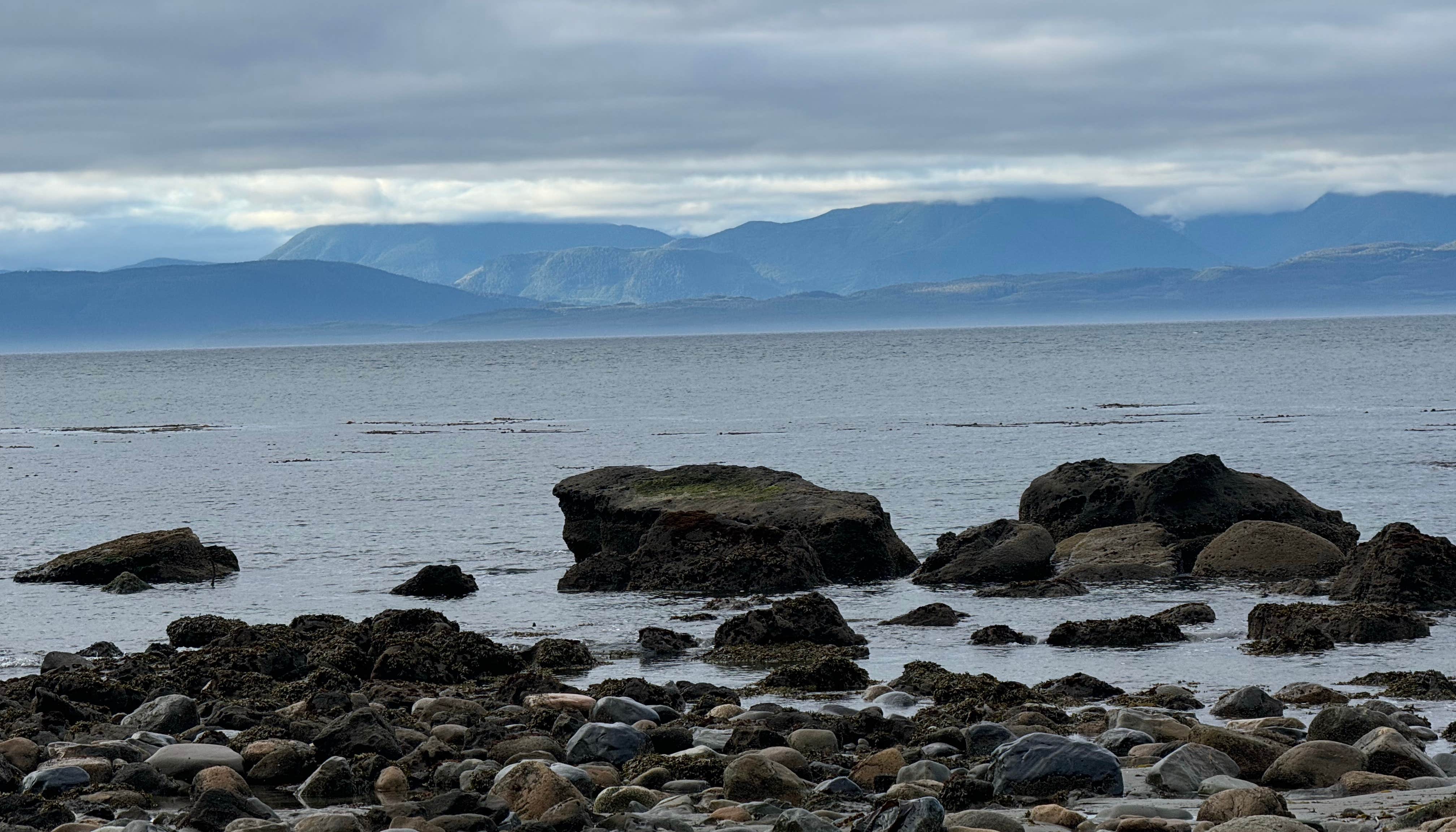Complete Guide to Camping in Olympic National Park
Olympic National Park sprawls across nearly a million acres of Washington's Olympic Peninsula, protecting glacier-capped peaks, ancient temperate rainforests, and over 70 miles of wild Pacific coastline. This diverse landscape - from the moss-draped Hoh Rain Forest to the windswept beaches at Kalaloch - offers varied camping experiences across ecosystems found nowhere else on Earth. The National Park Service manages 16 campgrounds with about 910 sites total, plus backcountry camping throughout the wilderness interior. Most sites operate first-come, first-served with basic amenities and no hookups, though Kalaloch Campground requires reservations during summer months. Seasonal weather ranges from mild, dry summers with highs around 70°F to cool, wet winters bringing up to 140 inches of annual rainfall in the Hoh Rain Forest. This guide covers campgrounds, planning logistics, activities, regulations, and insider tips for a safe and memorable Olympic National Park camping trip.
Olympic National Park Camping at a Glance
All Olympic campgrounds now require awareness of the park's unique first-come, first-served system, with only Kalaloch and Sol Duc accepting advance reservations. Most campgrounds open by late May and operate through September, though several remain open year-round with limited services. For 2025, Staircase Campground remains closed due to Bear Gulch Fire damage, and some coastal sites at Kalaloch face temporary closures from erosion. Sites range from $20-$33 per night for standard campgrounds, with Sol Duc Hot Springs RV Park costing $33-$58 depending on hookups. Summer nights can drop into the 40s-50°F even along the coast, so pack warm sleeping gear regardless of when you visit.
Olympic National Park Campground Quick Facts
| Quick Facts | Details |
|---|---|
| Number of Campgrounds | 16 park campgrounds with approximately 910 total sites across coastal, rainforest, and mountain regions |
| Total Campsites | ~910 sites total. Kalaloch: 170, Hoh: 78, Mora: 94, Heart O' the Hills: 97 |
| Campsite Costs | $20-$33 per night for standard sites $33-$58 per night Sol Duc Hot Springs (includes RV hookups) |
| Reservation Platforms | Recreation.gov (Kalaloch and Sol Duc only); all other campgrounds first-come, first-served |
| Camping Seasons | Many campgrounds open year-round; busy camps operate mid-May through late September |
| Temperature Ranges | Summer: Days 65-75°F, Nights 40-55°F Winter: Days 35-50°F, Nights 25-40°F |
| 2025 Updates | Staircase Campground closed (Bear Gulch Fire damage) Some Kalaloch coastal sites closed due to erosion |
Olympic Campgrounds: Complete Guide
Coastal Campgrounds
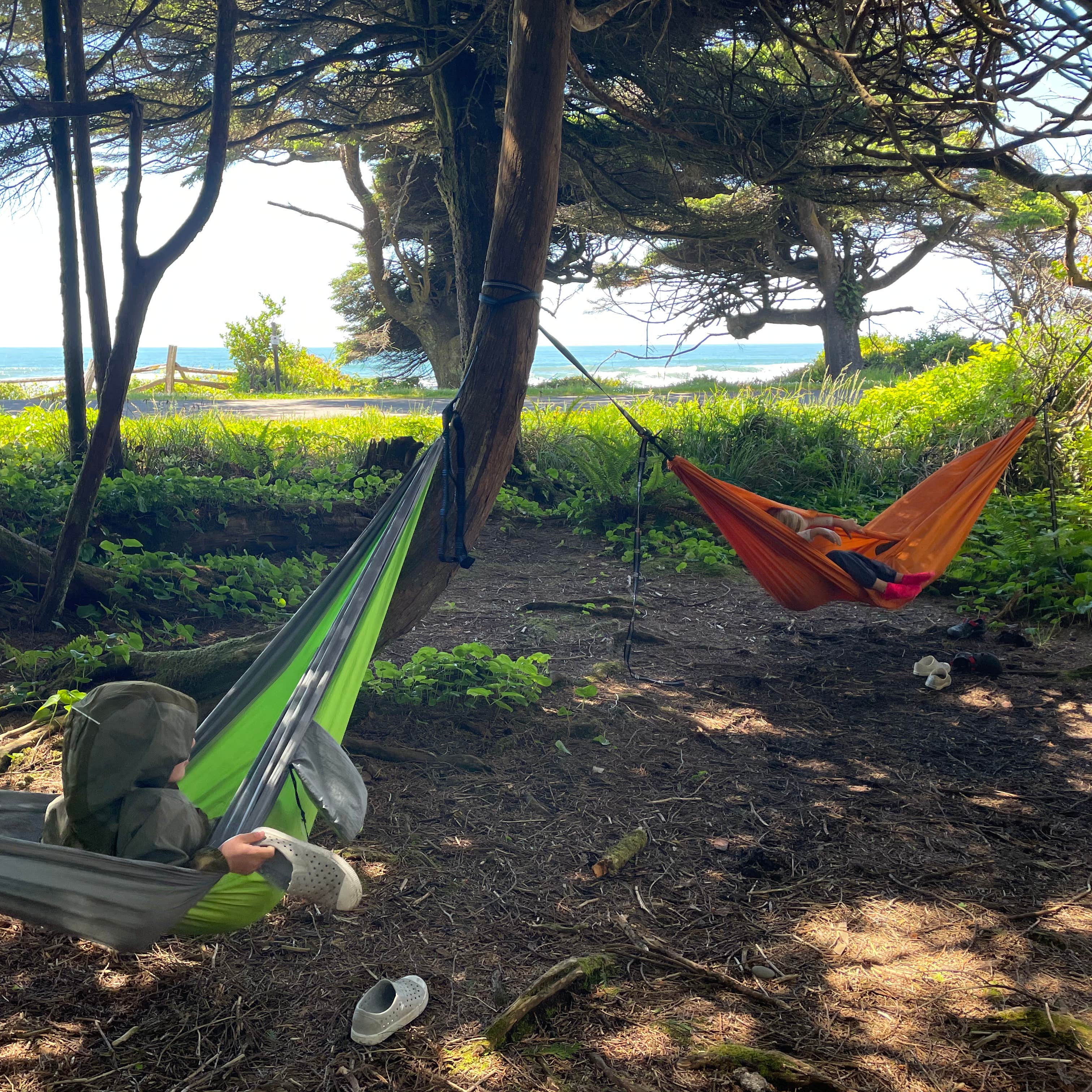
Kalaloch Campground - group — Olympic National Park
Kalaloch Campground sits on a bluff overlooking the Pacific Ocean on the park's western boundary, offering 170 campsites including one group site. Most sites include picnic tables and fire rings with flush toilets and potable water available throughout the campground. Beach access and tidepooling opportunities sit steps away, though tide charts should be checked before exploring. A self-service dump station costs $10. Kalaloch accepts reservations mid-May through mid-September on a 6-month rolling schedule by loop, operating first-come, first-served outside that window. Popular ocean-view loops (A, D, E) fill fastest during reservation windows. The campground provides access to Ruby Beach just minutes away. During winter, severe weather may temporarily close sections of the campground.
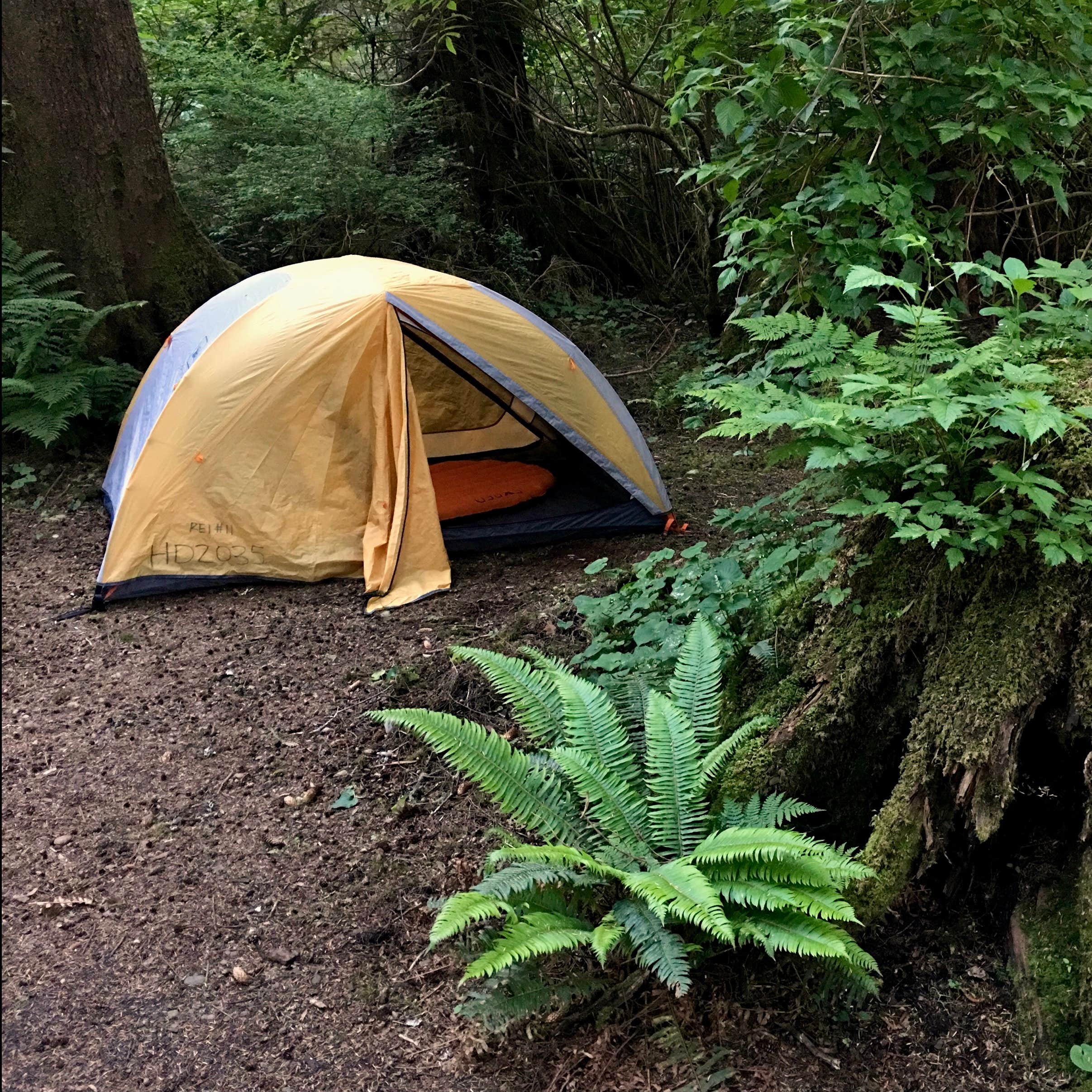
Mora Campground — Olympic National Park
Mora Campground nestles in mossy coastal forest near the Quillayute River, just 2 miles north of Rialto Beach. The campground contains 94 sites with a dump station available in summer for $10. Each site includes a picnic table, fire ring with grill grate, plus access to potable water and flush toilets. Some sites sit shaded and quiet along forest trails, while others perch above the river providing water views. Reservations are required May through September, with first-come, first-served availability outside peak season. Sites accommodate most vehicles, though RVs longer than 30 feet face challenges on narrow access roads. Mora's proximity to Rialto Beach, Second Beach, and nearby rain forest makes it highly popular. Summer weather often brings cool, foggy conditions typical of the Olympic coast.
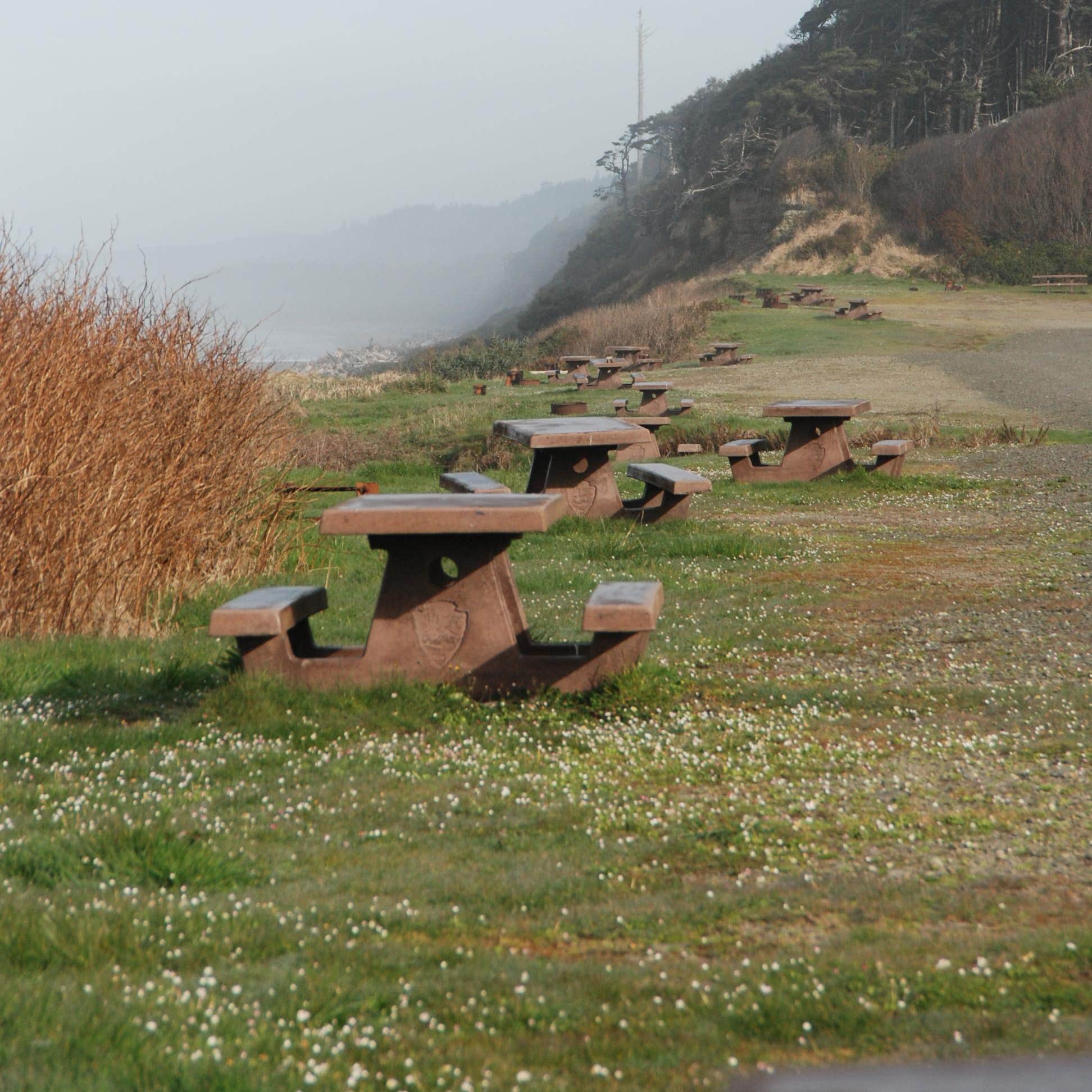
South Beach Campground — Olympic National Park
South Beach Campground sits on an ocean bluff with panoramic Pacific views, containing 55 sites with several perched directly above the beach. Sites include picnic tables and fire rings, with pit or flush toilets available but no potable water. South Beach operates first-come only (no reservations) from May through October. The scenic and quiet setting proves ideal for sunset watching, though the steep drop-off to the beach requires caution. Dogs are allowed on leash on nearby beach trail sections.
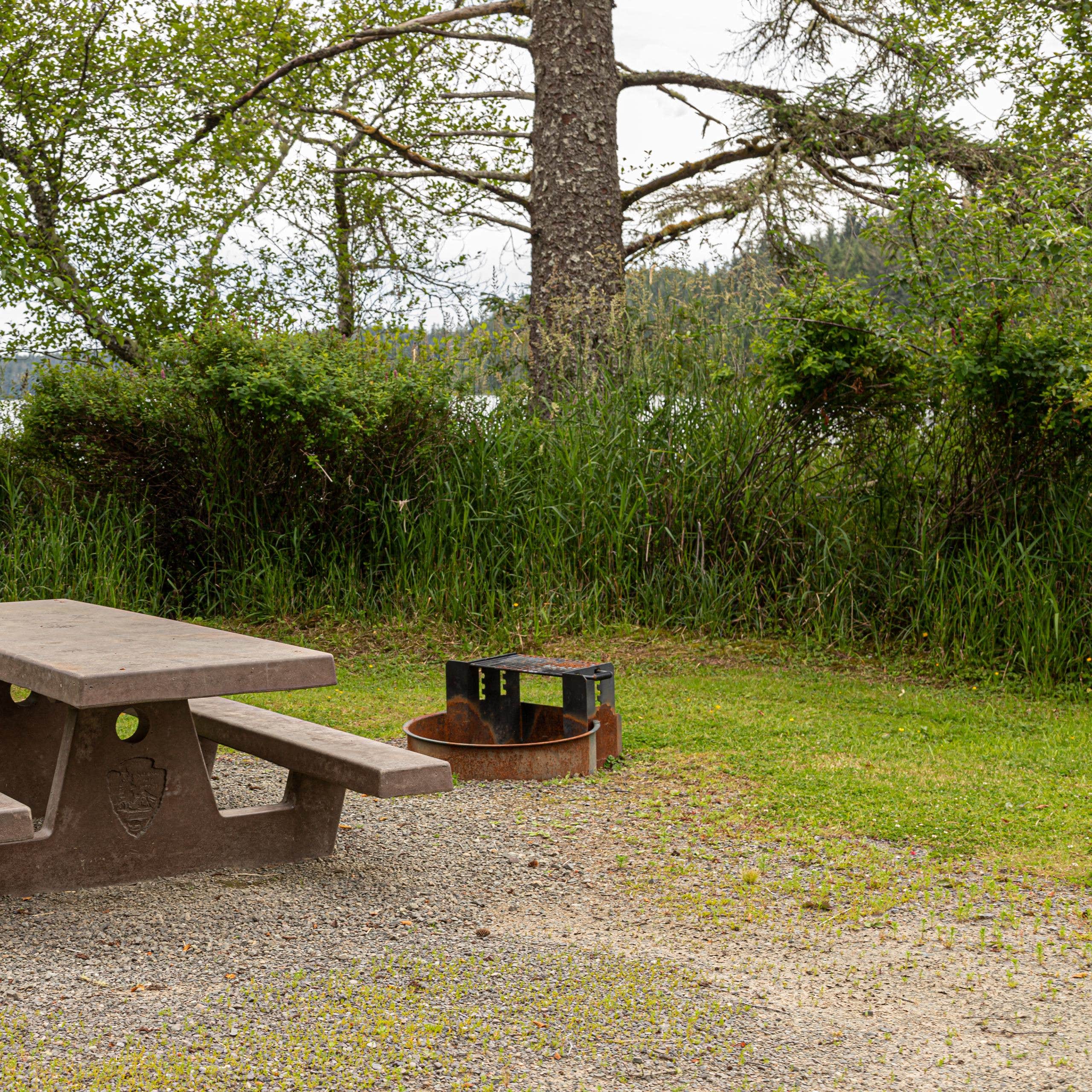
Ozette Campground — Olympic National Park
Ozette Campground at Lake Ozette provides primitive lakeside camping with 15 sites operating first-come, first-served year-round. Sites back up to the lake or forest, equipped with picnic tables and fire rings. Flush toilets and potable water are available in summer, though some low-lying sites may flood during winter months. The remote location requires a 3-mile drive on gravel roads, creating a quiet atmosphere with access to the Ozette River Trail and wild coastline beyond. The nearby Ozette Ranger Station provides information when staffed.
Rainforest & River Campgrounds
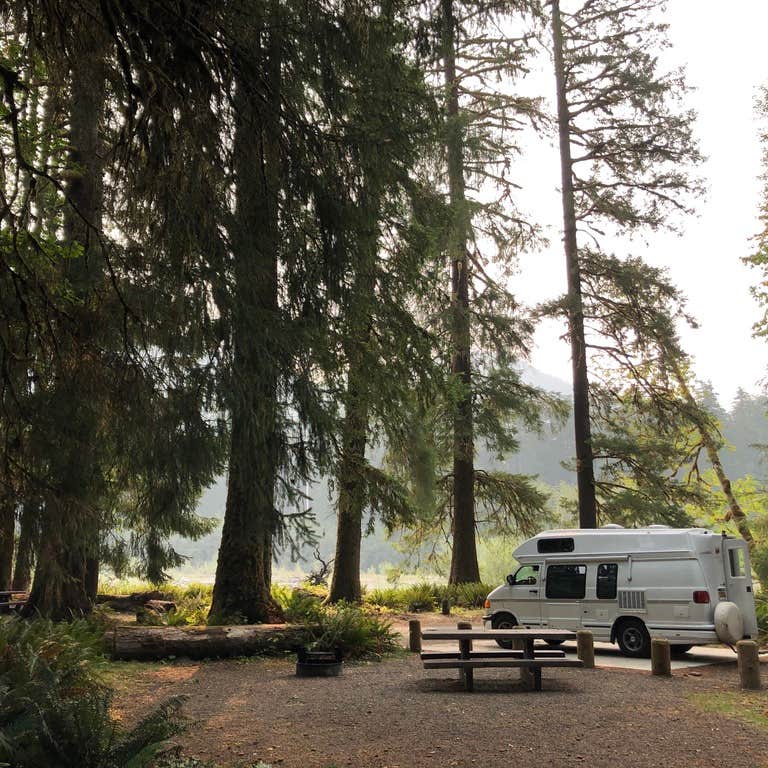
Hoh Campground — Olympic National Park
Hoh Rain Forest Campground immerses visitors in primeval moss-covered woods with 78 sites nestled under towering Sitka spruce and western hemlock along the Hoh River. Flush toilets and potable water spigots serve the campground centrally. Sites accommodate tents and moderate-size RVs up to 35 feet, with self-service food lockers provided at each site. Reservations are required June through September on a 6-month rolling window, with first-come availability outside peak season. The setting delivers lush ferns, near-constant rainfall averaging 140 inches per year, and abundant wildlife including deer and elk. The Hoh Trail starts steps from the campground. A 7-night stay limit applies during summer. The nearby ranger station and small store operate seasonally.
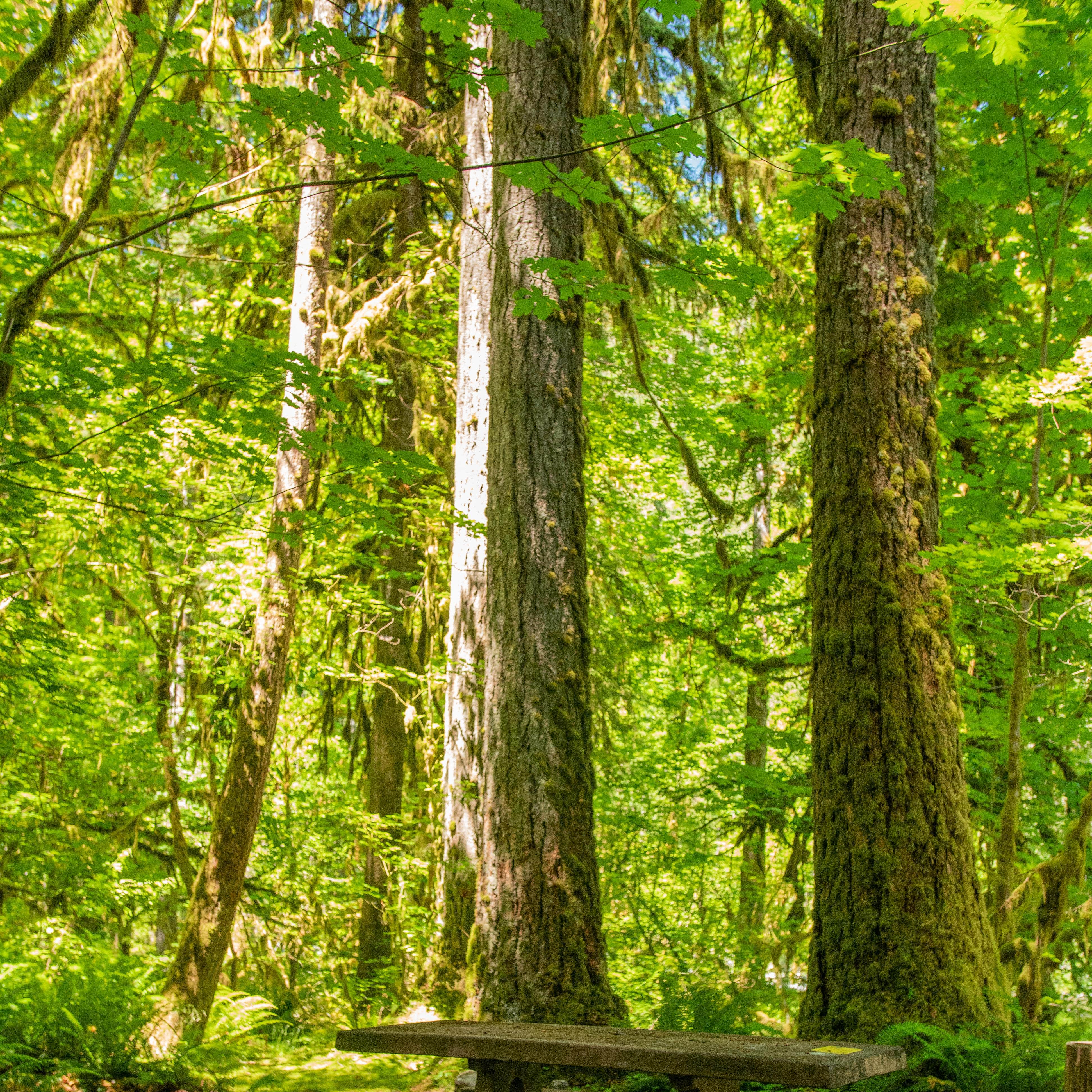
Graves Creek Campground — Olympic National Park
Graves Creek Campground sits deep in the Quinault Rain Forest south of Lake Crescent, offering 30 sites on a shaded hillside by a stream. Only pit toilets are available with no potable water or hookups. The campground operates year-round on a first-come basis, providing quiet, scenic camping among big trees beside a bubbling brook. The Graves Creek Trail departs from the campground for adventurous day hikes. The rough access road makes RVs and trailers inadvisable.
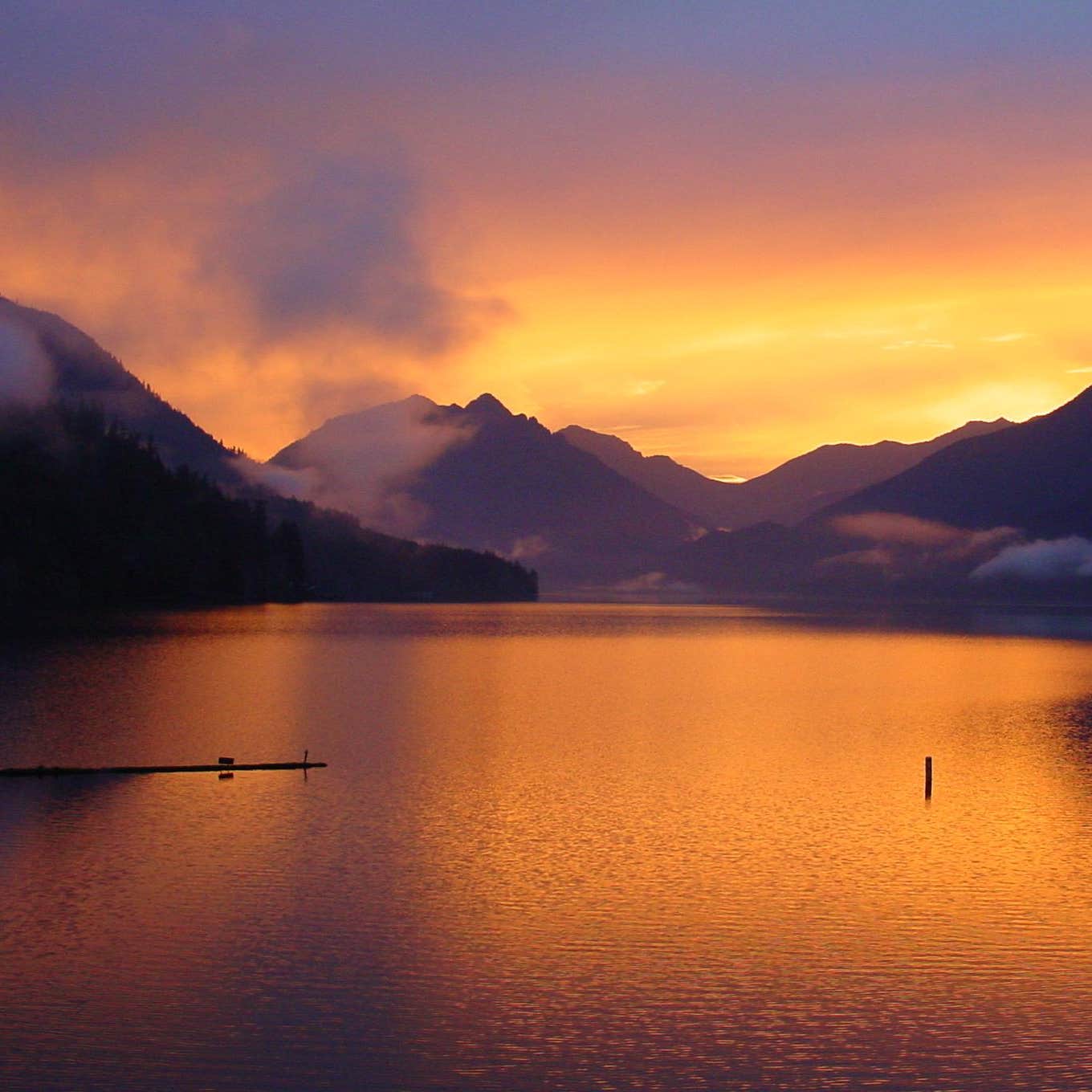
Fairholme Campground — Olympic National Park
Fairholme Campground sits on the north shore of crystal-clear Lake Crescent at 1,200 feet elevation, containing 88 drive-in and lakeside sites. Flush toilets, potable water, and a dump station serve campers. Sites include picnic tables and fire rings with views of surrounding peaks and kayak launch access. Reservations through Recreation.gov are required May through September, with the campground closed in winter. Sites accommodate RVs up to 35 feet but offer no hookups. Lake Crescent Lodge sits nearby. Fishing for cutthroat trout, boating, and hiking the Spruce Railroad Trail provide popular day activities.
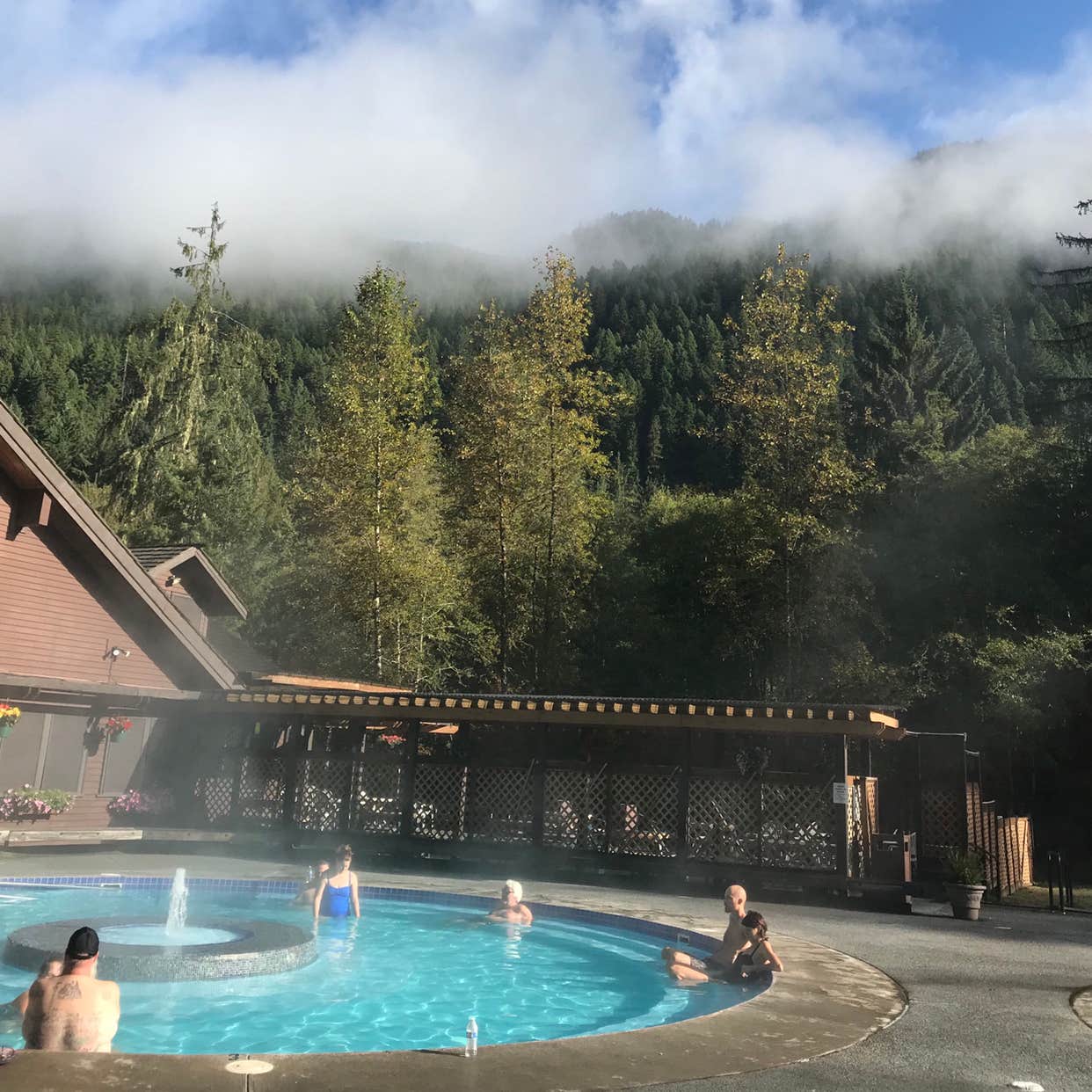
Sol Duc Hot Springs Resort Campground — Olympic National Park
Sol Duc Hot Springs RV Park & Campground operates as a privately run facility on park land, combining a rustic campground with 82 sites and an adjacent RV park with 17 sites. Campground sites sit in shaded forest, all with fire rings and picnic tables plus flush toilets and potable water. RV Park sites offer full hookups (water, electric, sewer) and showers. Fees run approximately $33 per night for campsites and $58 per night for RV hookups. Reservations are required March through November via Recreation.gov or the resort phone line, with some primitive Loop A sites opening March 21. In winter, only tent sites remain open on a primitive basis. On-site hot spring pools (fee required) complement river fishing and easy access to Sol Duc Falls trail.
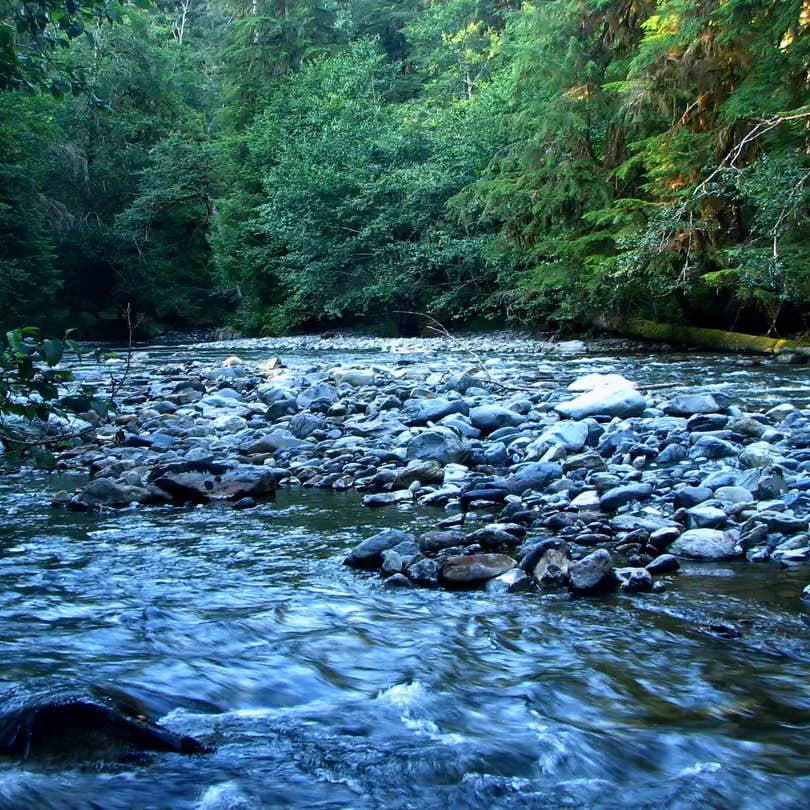
Staircase Campground — Olympic National Park
Staircase Campground sits on the east side near the Skokomish River in old-growth forest, containing 49 sites with picnic tables and fire rings. Flush toilets and potable water are provided during summer (mid-May through September), then removed for winter. Reservations are required late May through early September via Recreation.gov, with first-come availability otherwise. Staircase offers a wilderness feel with river fishing, hiking to Lake Cushman, and summer ranger talks in July and August. Due to recent wildfire damage, Staircase remains closed for 2025 - check current conditions before planning a visit.
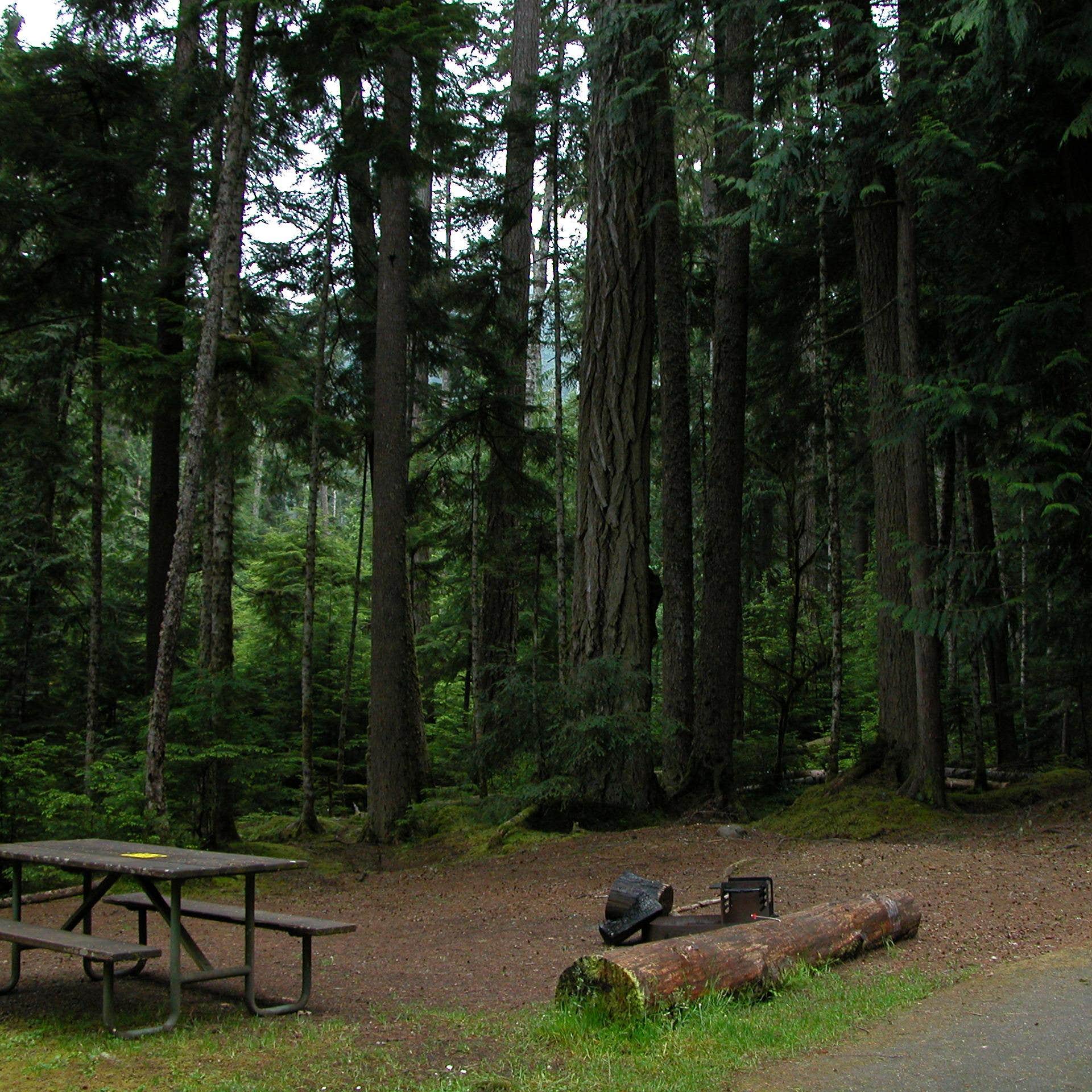
Heart O' the Hills Campground — Olympic National Park
Heart O' the Hills Campground sits in subalpine forest at the base of Hurricane Ridge, offering 97 sites with flush toilets and potable water year-round. The campground operates on a walk-in basis with no reservations accepted, including self-registration during winter snow conditions. Most sites fit RVs up to 21 feet with a few accommodating up to 35 feet. Amenities include picnic tables and fire pits. This campground proves popular with families for campfire programs in summer and trail access to Hurricane Ridge and alpine hiking. Bear boxes at each site ensure proper food storage.
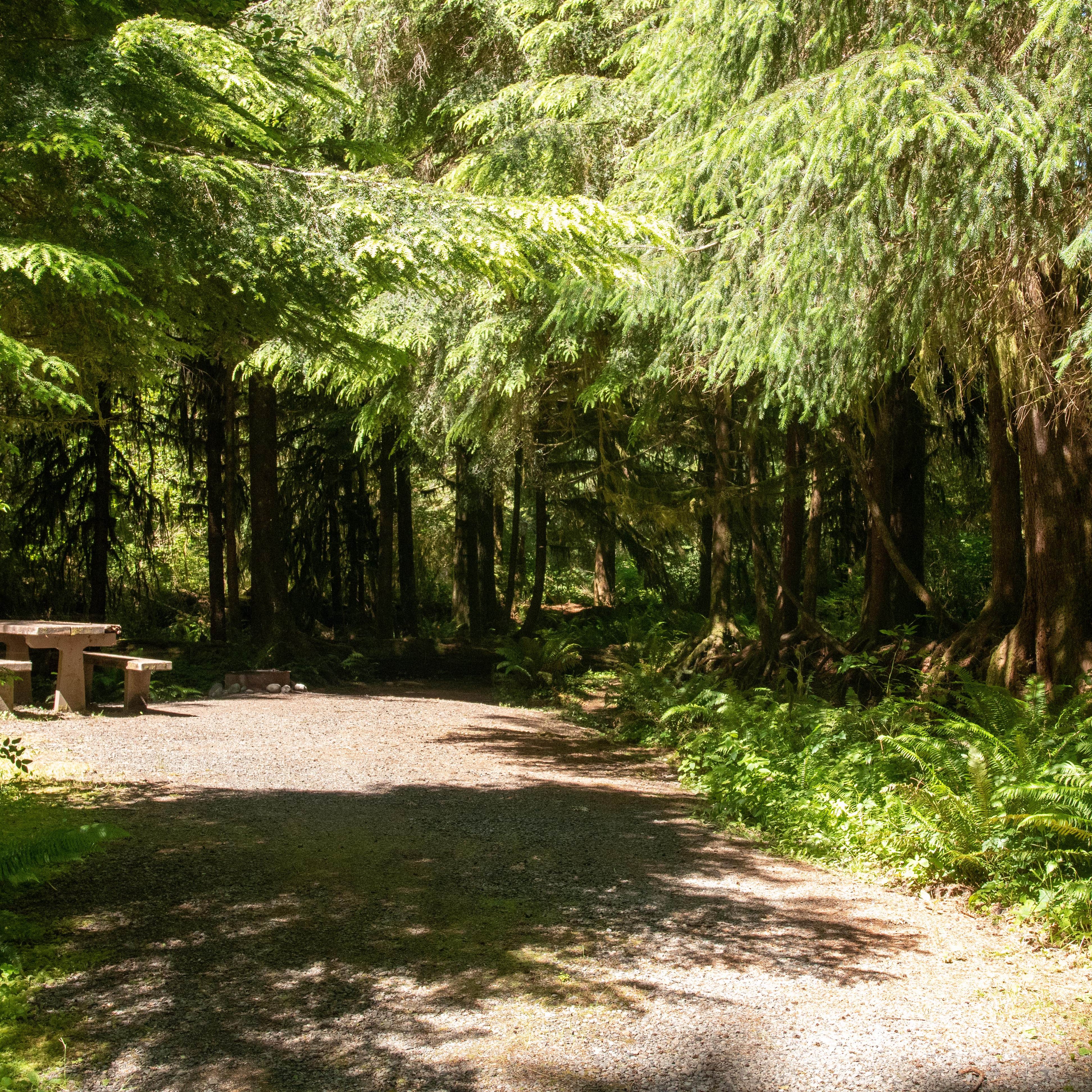
North Fork Campground — Olympic National Park
North Fork Campground provides a hidden gem near Lake Quinault in the park's southwest corner, with only 9 small sites in a woods setting. A vault toilet serves the campground with no water available - visitors must bring their own. Operating first-come year-round, the primitive campground isn't recommended for RVs or trailers. This tiny site proves perfect for trout fishing or accessing the North Fork Quinault River Trail with guaranteed solitude. No services or cell signal exist in the area.
Olympic Campground Comparison Table
| Campground | Location & Sites | Cost & Reservations |
|---|---|---|
| Kalaloch | Pacific coast bluff 170 sites | $20-24 Reservations mid-May-Sept |
| Hoh Rain Forest | Hoh Valley old-growth 78 sites | $20-24 Reservations summer |
| Heart O' the Hills | Hurricane Ridge base 97 sites | $20-24 First-come only |
| Mora | Coastal forest 94 sites | $20-24 Reservations mid-May-Sept |
| Sol Duc Hot Springs | River valley 82 camp / 17 RV | $33 camp / $58 RV Reservations March-Nov |
| Staircase | Skokomish River 49 sites | $20-24 CLOSED 2025 |
| Fairholme | Lake Crescent 88 sites | $20-24 Reservations May-Sept |
| South Beach | Ocean bluff 55 sites | $20-24 First-come only |
Campground Amenities and Best Uses
Coastal Options: Kalaloch offers ocean-view sites with beach access and tide-pooling steps away. Mora provides mossy coastal forest camping near Rialto Beach and Second Beach trailheads. South Beach delivers panoramic Pacific views from bluff-top sites. Ozette sits lakeside with access to wild coastline beyond.
Rainforest Camping: Hoh immerses campers in giant ferns and dripping moss under towering old-growth trees. Graves Creek offers deep Quinault Rain Forest solitude. Fairholme combines lakeside scenery with mountain views at Lake Crescent.
Mountain Access: Heart O' the Hills provides subalpine forest camping at Hurricane Ridge's base with starry evening skies. The campground serves as gateway to alpine hiking and meadow exploration.
RV Options: Sol Duc Hot Springs RV Park provides the only full hookups inside park boundaries but operates through a private concessionaire. For additional Olympic National Park RV camping options, several private parks near gateway towns offer full amenities. The park's developed campgrounds accommodate RVs at most sites but provide no hookups.
Dispersed Camping: Inside park boundaries, camping is restricted to designated campgrounds only. However, Olympic National Forest dispersed camping surrounds the park with numerous free, primitive sites. The Dosewallips, Duckabush, and other National Forest areas provide backcountry camping opportunities for those seeking true solitude.
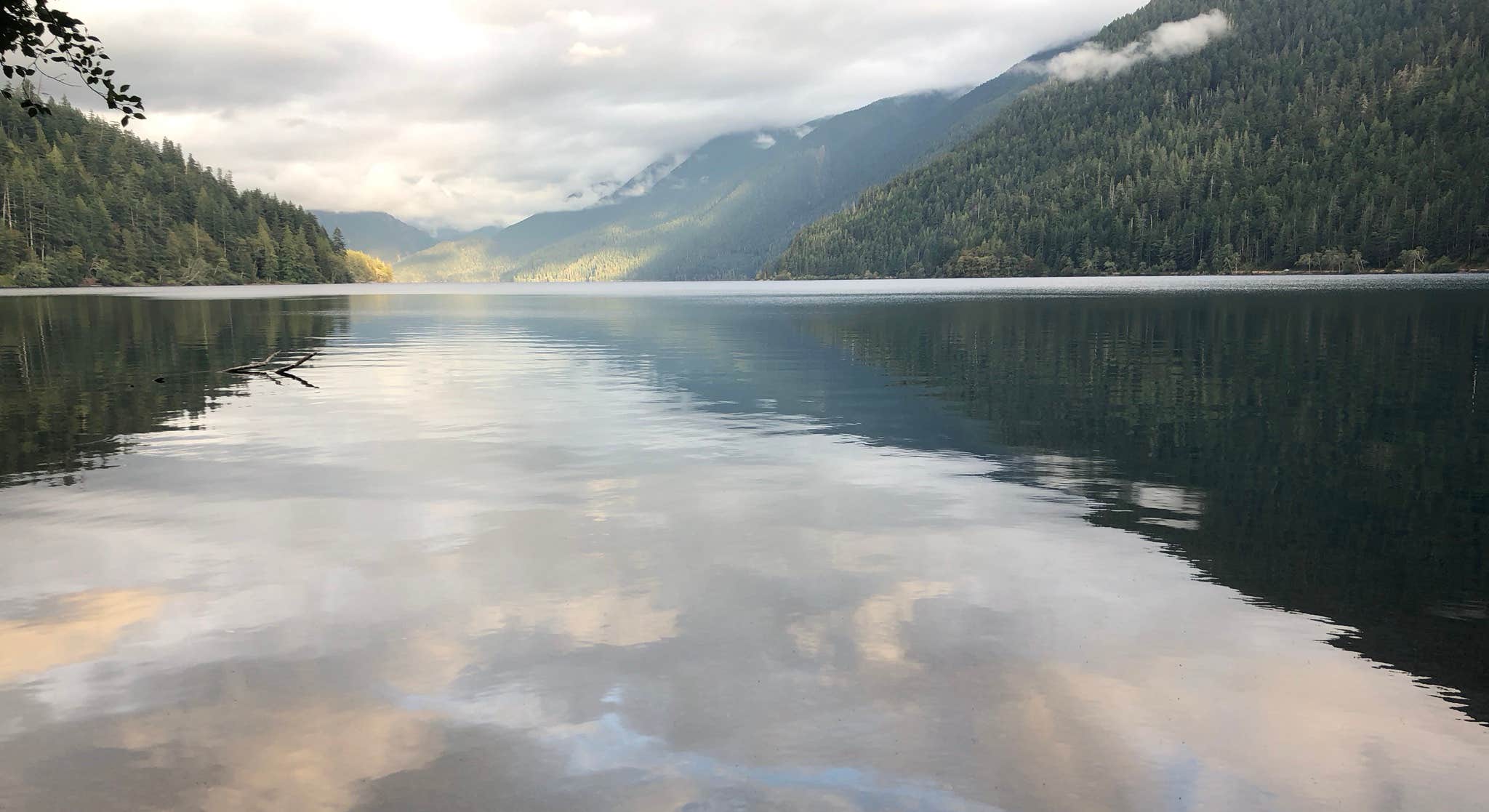 Photo by Ben S
Photo by Ben S
Planning Your Olympic Camping Trip 
When to Visit Olympic NP
| Season | Temperatures | Camping Conditions |
|---|---|---|
| Spring (April-May) | Days: 50-60°F Nights: 35-45°F | Cool and wet with lingering snow at elevation Lower campgrounds begin reopening Waterfalls at peak flow |
| Summer (June-August) | Days: 65-75°F Nights: 45-55°F | All campgrounds open Warmest and driest conditions Peak visitation period |
| Fall (September-October) | Days: 55-65°F Nights: 40-50°F | Rain returns with thinning crowds Most campgrounds close by late October Fall colors emerge in valleys |
| Winter (November-March) | Days: 35-50°F Nights: 25-40°F | Cold and wet valleys, heavy mountain snow Limited campground availability Solitude for hardy winter campers |
Spring (April-May): Early spring brings quiet but cold camping conditions. Roads begin reopening by mid-April, and lower-elevation campgrounds start operating in May. Daytime temperatures hover in the 50s-60°F with freezing nights still possible. Snow lingers at higher elevations through late spring. Wildlife viewing excels as animals emerge with their young, including bear cubs and Roosevelt elk calves. Late spring often showcases abundant waterfalls and blooming wildflowers, though rain gear remains essential. Crowds stay light until Memorial Day weekend.
Summer (June-August): Peak season sees all campgrounds open and warmest conditions. Days warm to 65-75°F at lower elevations with cool nights in the 40s-50°F. July and August bring the driest, sunniest weather. Full access exists to trails, visitor centers, and activities, but expect crowds at popular areas and campgrounds operating at capacity. Coastal fog remains common even during summer months. Starting days early helps beat traffic and secure first-come sites.
Fall (September-October): Fall marks a transition toward quieter conditions, especially after Labor Day. September maintains summer-like temperatures with slightly cooler nights and decreased crowds. Rain returns in earnest by October, and days shorten significantly. Many campgrounds close by late October as winter approaches. Fall colors peak mid-September with deciduous trees turning golden, particularly at lower elevations. Roosevelt elk bugling occurs during fall rut near coastal forests.
Winter (November-March): Winter transforms Olympic into a quieter landscape with dramatically reduced crowds. Cold and wet conditions prevail in valleys (30s-40s°F daytime), while heavy snow blankets the mountains. Camping continues year-round at Heart O' the Hills (often walk-in only) and Kalaloch (weather permitting), with limited sections of other campgrounds occasionally open. Hurricane Ridge access requires chains and winter preparedness. Winter camping offers solitude but demands proper gear and planning for harsh conditions.
Olympic Reservation Systems Explained
Most Olympic campgrounds operate on a first-come, first-served basis year-round, requiring flexibility and early arrival during peak season. The two exceptions - Kalaloch Campground and Sol Duc Hot Springs - accept advance reservations through different systems.
Kalaloch Reservations: Book through Recreation.gov on a 6-month rolling schedule, with reservations opening by loop. The system releases blocks of sites throughout the year, so monitoring availability regularly increases chances of securing ocean-view loops. Sites book quickly once released, particularly for summer weekends. Create your Recreation.gov account beforehand and log in before the booking window opens.
Sol Duc Reservations: Book RV Park sites (17 hookup sites) and primitive loop sites via Recreation.gov or by calling the resort directly. The 6-month booking window typically opens in late winter for summer season access. RV sites with full hookups cost more than standard campground sites.
First-Come Strategy: For all other campgrounds (Mora, Hoh, Heart O' the Hills, etc.), arrive early in the morning - ideally before 9:00 AM - to secure sites during peak season. Midweek arrivals offer better availability than weekends. Check with campground hosts or ranger stations about typical fill times and seasonal patterns.
Backcountry Permits: Overnight trips into Olympic's wilderness require permits available at the Wilderness Information Center or in advance through Recreation.gov. The backcountry permit system typically opens in spring for the upcoming season. For information on Olympic National Park dispersed camping in the backcountry, contact the Wilderness Information Center for current regulations and availability.
Campground Costs and Budgeting
| Campground Type | Nightly Cost | Key Features |
|---|---|---|
| Standard Campgrounds | $20-24 | Flush or vault toilets, picnic tables, fire rings, food storage lockers |
| Basic Sites | $15-20 | Small campgrounds with vault toilets, limited or no water |
| Sol Duc Campground | $33 | Forest sites near hot springs, flush toilets, potable water |
| Sol Duc RV Park | $58 | Full hookups (water, electric, sewer), shower access |
| Group Sites | $40-45 | Kalaloch and select campgrounds, accommodate larger parties |
Additional Costs and Budget Tips
Park and Entry Fees: Olympic charges $10 per vehicle for a 7-day entrance pass, or $30 for an annual park pass. The America the Beautiful Pass at $80 annually covers all national parks and provides excellent value for multi-park visitors.
Facility and Service Fees: Dump stations at Kalaloch, Mora, Hoh, and Fairholme cost $10 for self-service. Firewood costs $5-10 per bundle from local vendors. The Sol Duc Hot Springs pools require a separate day-use fee.
Budget-Friendly Alternatives: Olympic National Forest campgrounds surrounding the park cost $5-15 per night with basic amenities. Dispersed camping spots near Olympic National Park on National Forest land provide free primitive camping for self-sufficient campers. Off-season visits in April-May and September-October offer lower visitation and better walk-up availability.
Permit Costs: Backcountry wilderness permits cost $5 plus $2 per person per night. Fishing in park waters requires a Washington State fishing license.
Essential Gear for Olympic Camping
Pack prepared for Olympic's maritime climate and variable weather across ecosystems:
Sleeping Gear:
- Tent with waterproof rainfly and footprint (critical for wet conditions)
- Warm sleeping bag rated for at least 30°F
- Insulated sleeping pad with R-value of 3 or higher
- Extra blanket for unexpected cold snaps
- Warm layers for sleeping
Kitchen Setup:
- Camp stove and extra fuel (wood may be wet)
- Water filter or purification method (some campgrounds lack potable water)
- Bear-resistant food storage containers for backcountry
- Cooler with block ice for car camping
- Lightweight cookware and utensils
- Dish washing supplies
Clothing:
- Complete layering system for 30-70°F temperature range
- Waterproof rain jacket and pants (non-negotiable)
- Moisture-wicking base layers
- Insulating mid-layers (fleece or synthetic)
- Warm hat and gloves
- Sturdy waterproof hiking boots
- Camp shoes or sandals
Safety and Navigation:
- Bear spray (recommended, especially in backcountry)
- First aid kit with blister treatment
- Headlamp with extra batteries
- Printed maps (cell service is extremely limited)
- Compass or GPS device
- Tide tables for coastal exploration
Other Essentials:
- Sun protection (sunscreen, hat, sunglasses)
- Insect repellent for summer months
- Dry bags or waterproof stuff sacks
- Rope or cord for hanging food in backcountry
- Repair kit with duct tape
- Biodegradable soap
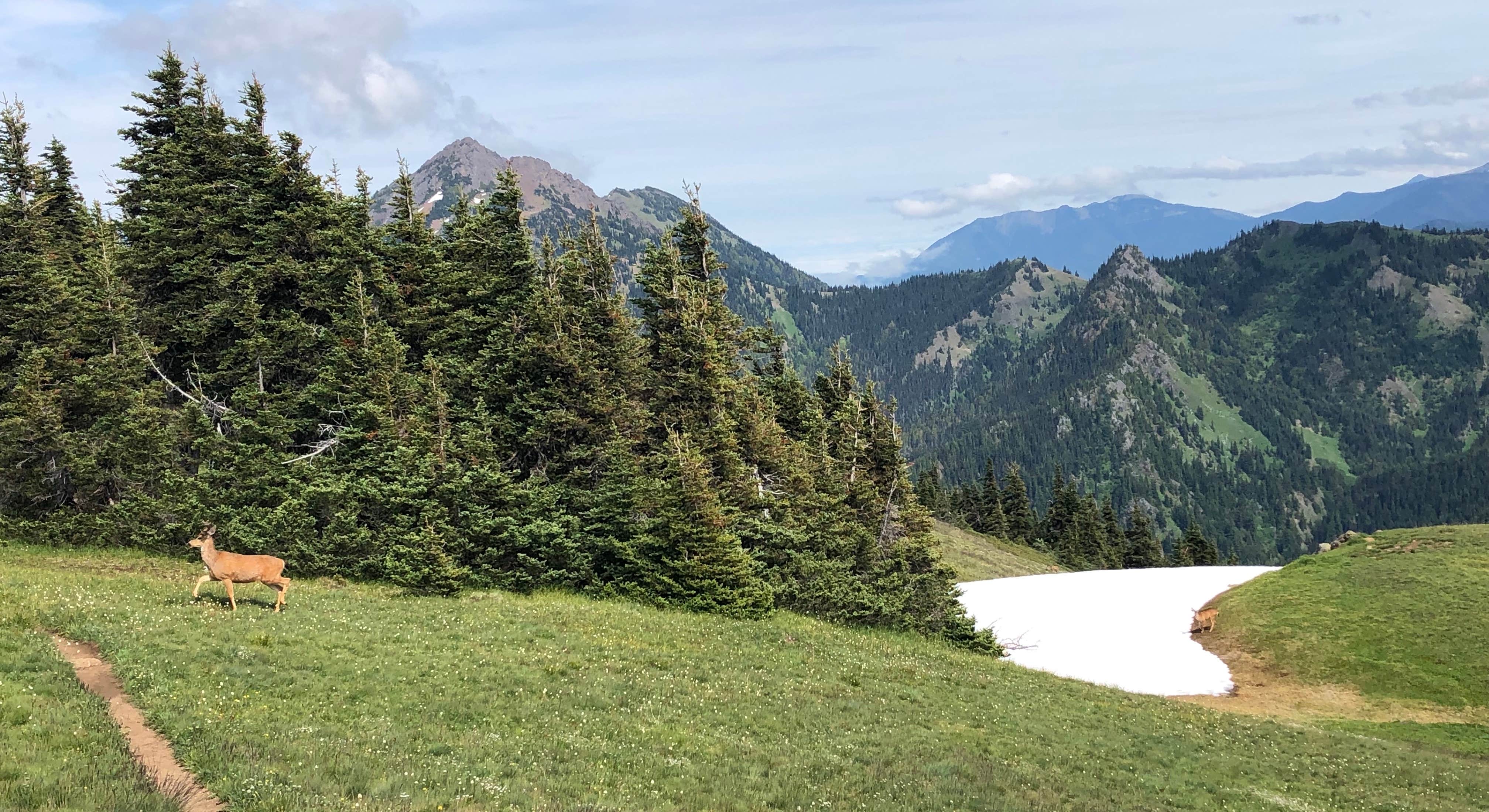 Photo by Mom S
Photo by Mom S
Wildlife Safety and Park Regulations 
Black Bear and Wildlife Safety
Olympic hosts significant black bear populations that regularly visit campgrounds, plus mountain lions, Roosevelt elk, and abundant smaller wildlife. Proper food storage isn't optional - it's mandatory for your safety and the animals' survival.
Food Storage Requirements:
- Store all food, trash, toiletries, and scented items in provided bear boxes or locked vehicles
- Never leave food unattended, even briefly
- Clean cooking areas thoroughly after every meal
- Dispose of dishwater in designated utility sinks, not on the ground
- Nothing scented may remain in tents overnight
- Coolers and food containers must be stored properly even when empty
Bear Encounter Guidelines:
- Maintain at least 50 yards distance from all bears and large wildlife
- If a bear approaches your campsite, make noise - yell, clap hands, bang pots
- Never approach, feed, or attempt to photograph bears up close
- Report all bear sightings to the nearest ranger station
- Carry bear spray when hiking and know how to use it
- In backcountry areas, hang food properly or use bear canisters
Mountain Lion Safety:
- Hike in groups when possible
- Keep children close and within sight
- If you encounter a cougar: make yourself appear large, maintain eye contact, back away slowly
- Never run from a mountain lion
- Fight back if attacked
Park Regulations and Etiquette
| Regulation Category | Specific Rules | Penalties |
|---|---|---|
| Campfires | Allowed only in designated fire rings Never leave unattended Subject to seasonal fire restrictions Completely extinguish before leaving | Fines starting at $125 Possible campground eviction |
| Food Storage | All food, trash, and toiletries in bear boxes or vehicles No food in tents Clean tables and grills after use | Fines starting at $100 Possible eviction |
| Quiet Hours | 10:00 PM to 6:00 AM strictly enforced Generator use restricted to limited hours (check campground rules) | Warning then possible eviction |
| Pets | Leashed at all times in campgrounds Prohibited on most trails Allowed on select beach sections only | Citations and fines |
Additional Park Regulations
Camping Limits: Maximum 14 consecutive days per year in Olympic campgrounds. Kalaloch, Mora, and Hoh enforce 7-night limits during peak summer season. Maximum 6 people per site, maximum 2 vehicles per site.
Firewood Collection: Gather only dead-and-down wood smaller than 6 inches in diameter within 100 feet of your campsite below 3,500 feet elevation. Never cut standing trees or break branches from living trees. Purchase firewood locally to prevent introducing tree-killing pests.
Protected Resources: Do not collect plants, rocks, shells, driftwood, or artifacts. Stay on established trails to prevent erosion. No nails in trees or trenching around tents. Leave natural and cultural objects where found.
Pets: Dogs and cats must remain on leash at all times in developed areas. Pets are prohibited on all park trails except Spruce Railroad Trail, Peabody Creek Trail, and portions of Rialto Beach. For more information on pet-friendly camping near Olympic National Park, check nearby campgrounds outside park boundaries.
Water Activities: Fishing requires a Washington State fishing license. Swimming is permitted but rarely comfortable due to cold water temperatures. Boating is allowed on specific lakes with proper permits.
Beyond the Campground: Activities and Exploration 
Day Trips from Olympic Campgrounds
From Coastal Campgrounds: Kalaloch and Mora provide beach access with exceptional tide-pooling at Ruby Beach, Beach 4, and Rialto Beach. Sea stacks, driftwood, and dramatic ocean views line the entire coastal section. Cape Flattery at the northwest tip offers views of the Pacific and Tatoosh Island. The coastal strip between campgrounds features numerous pullouts and short beach access trails.
From Hoh Rain Forest: The Hall of Mosses Trail (0.8 miles) and Spruce Nature Trail (1.2 miles) showcase Olympic's temperate rainforest at its finest. The longer Hoh River Trail extends 17 miles into the wilderness, passing through old-growth forest before climbing toward Blue Glacier on Mount Olympus. Even a few miles on this trail provide spectacular rainforest immersion.
From Hurricane Ridge Area: Heart O' the Hills serves as gateway to Hurricane Ridge, where a scenic 17-mile drive climbs to alpine meadows at 5,242 feet. Hurricane Hill Trail (3 miles round-trip) offers panoramic views of the Olympic Mountains and, on clear days, Vancouver Island. Wildflowers peak in late July and early August. Winter brings downhill and Nordic skiing opportunities.
From Lake Crescent: Marymere Falls Trail (1.8 miles round-trip) leads to a 90-foot waterfall through old-growth forest. The Spruce Railroad Trail follows the historic railroad grade along the north shore with multiple access points and lake views. Storm King Ranger Station provides trail information and historical exhibits about the area.
From Sol Duc: Sol Duc Falls Trail (1.6 miles round-trip) reaches a dramatic waterfall splitting around a rock outcrop. The longer Lover's Lane Trail (6 miles round-trip) explores old-growth forest along the Sol Duc River. For Olympic National Park horse camping options, several backcountry trails in the area accommodate stock animals.
Top Hiking Trails Near Campgrounds
| Trail Name | Difficulty & Distance | Key Features |
|---|---|---|
| Hall of Mosses | Easy 0.8 miles loop | Moss-draped trees, accessible boardwalk, quintessential rainforest experience |
| Hurricane Hill | Moderate 3 miles RT | Alpine meadows, panoramic mountain views, wildflower displays in summer |
| Sol Duc Falls | Easy to Moderate 1.6 miles RT | Dramatic split waterfall, old-growth forest, river views |
| Marymere Falls | Easy to Moderate 1.8 miles RT | 90-foot waterfall, Lake Crescent access, forested trail |
| Second Beach | Easy 1.4 miles RT | Iconic sea stacks, tide pools, coastal forest, beach camping option |
| Ozette Triangle | Moderate 9.4 miles loop | Wild beaches, petroglyphs, sea arches, backcountry coastal camping |
Trail Access and Starting Points
Rainforest Trails: Hall of Mosses and Spruce Nature Trail both start from Hoh Rain Forest Visitor Center. The Quinault Rain Forest Loop Trail provides another old-growth experience near Lake Quinault.
Alpine Access: Hurricane Hill and other Hurricane Ridge trails start from Hurricane Ridge parking area, a 17-mile drive from Heart O' the Hills Campground. Arrive early as parking fills by mid-morning in summer.
Coastal Trails: Second Beach trailhead sits off La Push Road near Mora. Rialto Beach requires no hiking to access. The Ozette Triangle starts from Lake Ozette with overnight camping options at primitive beach sites.
Backcountry Access: For extended Olympic National Park tent camping trips, the park maintains extensive backcountry trail systems. Popular backpacking routes include the High Divide-Seven Lakes Basin loop, Enchanted Valley via the Quinault River, and various coastal routes requiring tide timing.
Water Activities in Olympic
Tidepooling: Olympic's rocky coastline creates exceptional tidepooling opportunities. Kalaloch, Ruby Beach, and Rialto Beach host abundant intertidal life including sea stars, anemones, crabs, and small fish. Always check tide charts and never turn your back on the ocean. Leave all creatures where found - touching or removing them is prohibited.
Fishing Opportunities: Rivers including the Sol Duc, Hoh, Queets, and Quinault offer salmon and steelhead fishing (check seasons and regulations). Lake Crescent holds cutthroat trout and kokanee. A Washington State fishing license is required for anglers 15 and older.
Boating and Paddling: Lake Crescent and Lake Ozette permit non-motorized boats. Kayak rentals are available at Lake Crescent during summer months. Ocean kayaking proves challenging due to waves and currents - only experienced paddlers should attempt coastal routes.
Swimming: The Elwha River offers swimming holes during summer. Lake Crescent's beaches provide cold but swimmable water. Ocean swimming faces extreme hazards from cold temperatures, rip currents, and surf - swim at your own risk and never alone.
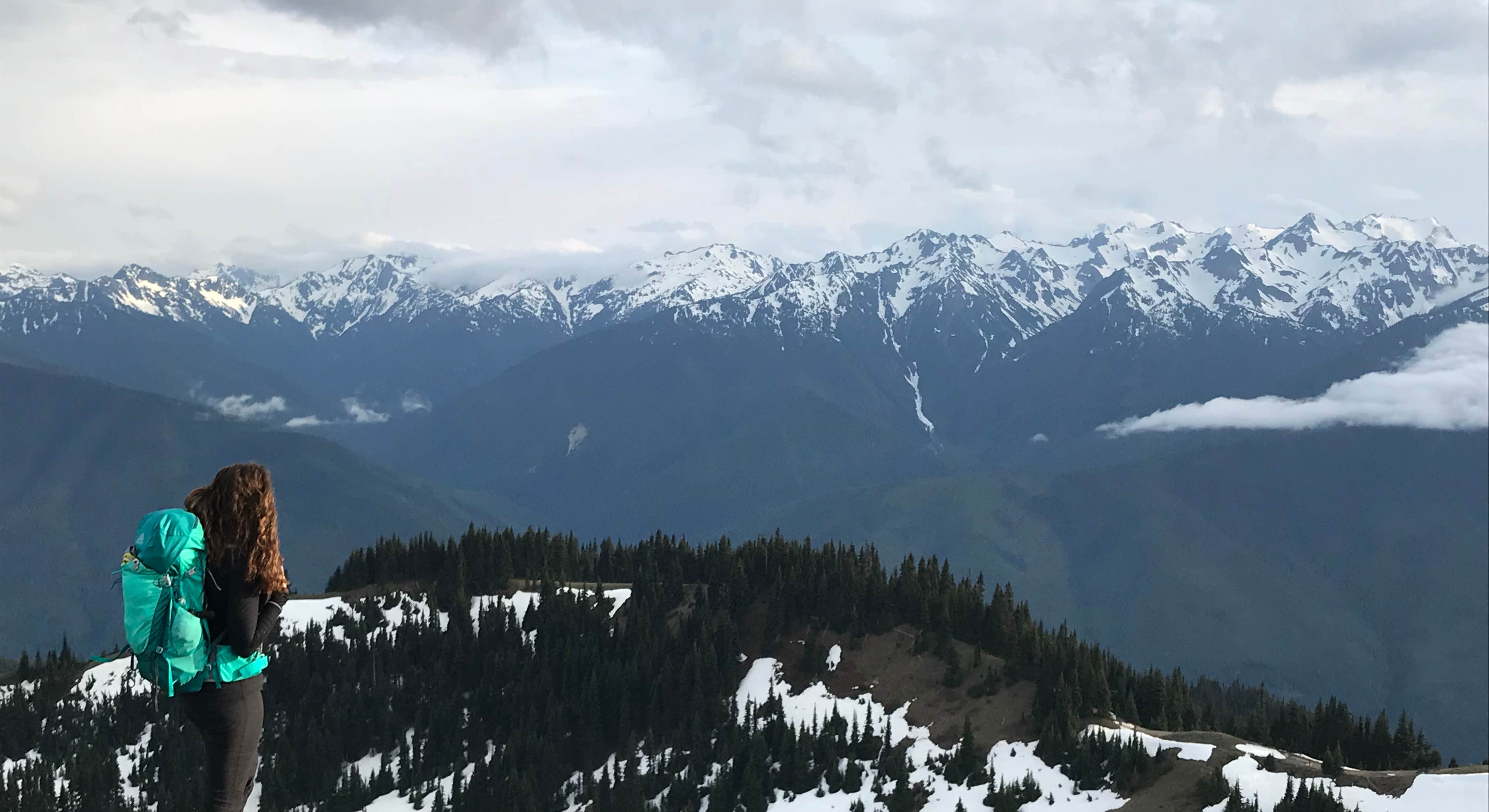 Photo by Emily C
Photo by Emily C
The Dyrt Community Insights 
Ranger Recommendations
The Dyrt Rangers offer these insider tips from experienced Olympic campers:
Best Sites for Ocean Views:
"At Kalaloch, sites A33 through A36 sit right on the bluff with unobstructed ocean views," notes one Pacific Northwest Ranger. "They book up instantly when reservations open, but the sunset views and sound of waves make the planning worthwhile. If those are taken, Loop D also offers several oceanview sites."
Hidden Gem Campground:
"Fairholme at Lake Crescent doesn't get enough attention," suggests a longtime Olympic visitor. "The mountain reflections in the lake rival anything in the Cascades, and you can kayak right from your campsite. Sites along the water's edge provide incredible scenery without the crowds of coastal campgrounds."
Rainforest Camping Favorite:
"Hoh Rain Forest Campground offers the most immersive old-growth experience," according to multiple Rangers. "Sites A13 through A20 sit closest to the river with the best combination of space and forest atmosphere. Morning mist through the trees creates an otherworldly feeling you won't find anywhere else."
Best for Solitude:
"North Fork Campground near Lake Quinault sees maybe a handful of campers per week even in summer," shares one Ranger. "With only 9 sites and zero amenities, it filters out casual visitors. If you want true wilderness quiet, this is it."
Top-Rated Sites from The Dyrt Community
| Category | Top Pick & Rating | Key Highlights |
|---|---|---|
| Highest-Rated Campground | Hoh Rain Forest 4.8/5 stars | Unmatched old-growth immersion, well-maintained facilities, wildlife viewing |
| Most Scenic | Kalaloch 4.7/5 stars | Ocean bluff sites, sunset views, beach access, tidepooling |
| Best Lake Camping | Fairholme 4.6/5 stars | Lake Crescent waterfront, mountain reflections, kayaking access |
| Most Family-Friendly | Heart O' the Hills 4.5/5 stars | Hurricane Ridge access, ranger programs, flush toilets, year-round operation |
Community Insights and Recommendations for Olympic NP
Ocean Camping Praise: Dyrt campers consistently rave about Kalaloch's combination of ocean views and convenient facilities. Reviews note "falling asleep to wave sounds" and "walking straight from your tent to tidepools at sunrise." Several campers mention the importance of bringing binoculars for whale watching from bluff-top sites.
Rainforest Immersion: Hoh campground receives enthusiastic reviews for its "cathedral-like atmosphere" and "prehistoric feeling." Campers recommend arriving early in the day to maximize wildlife viewing opportunities, particularly Roosevelt elk in adjacent meadows at dawn and dusk.
Alternative Options: For RV campers seeking full hookups, community members recommend Sol Duc Hot Springs despite higher costs, citing the hot spring pool access as "worth the premium." Several reviewers note that Olympic National Park glamping options near gateway towns provide comfortable alternatives during shoulder seasons.
Coastal Access: Mora Campground earns praise for proximity to multiple beaches. Reviewers recommend Second Beach for sunset photography and Rialto Beach for dramatic sea stacks. Community members emphasize checking tide tables before beach exploration.
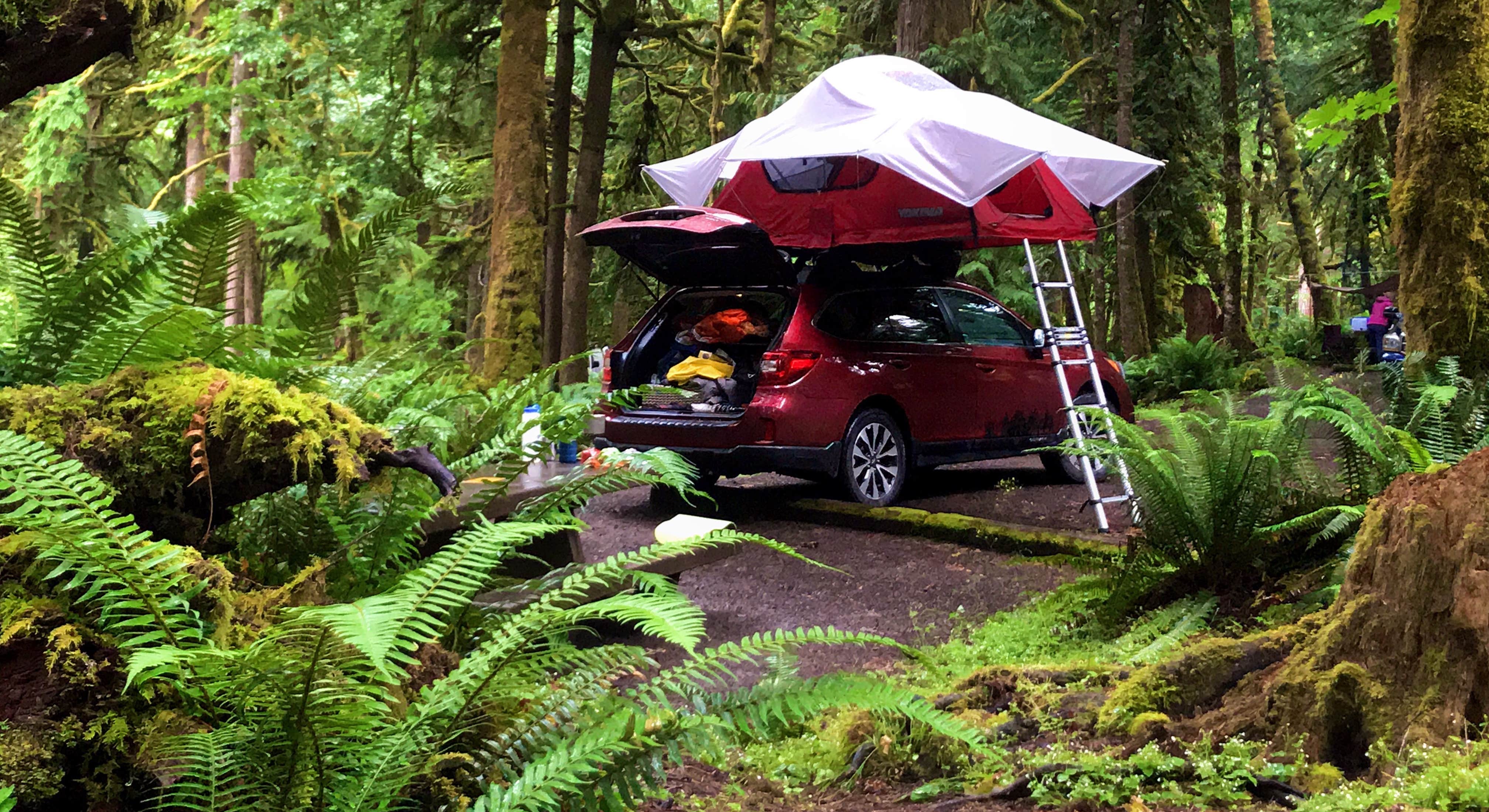 Photo by Kelly G
Photo by Kelly G
Responsible Camping Practices 
Camping in Olympic's fragile ecosystems requires thoughtful practices to preserve the park for future generations:
Pack It In, Pack It Out: Carry out everything you bring in, including all trash, food scraps, and microtrash like wrappers and bottle caps. Pick up litter left by others to leave sites cleaner than you found them. Dispose of garbage in provided bear-resistant receptacles or pack it out entirely. Even biodegradable items like orange peels and apple cores should be packed out - they don't belong in Olympic's ecosystems.
Food Storage Requirements: Use provided bear boxes at every campsite for all food, toiletries, and scented items. Lock items in vehicles if bear boxes aren't available. Never store food in tents overnight. Clean cooking areas immediately after meals and store dirty dishes with food items. Even empty coolers must be stored properly as bears recognize them as food sources.
Stay on Established Trails and Sites: Camp only in designated campsites to prevent widening impact areas. On trails, stay on the established path even when muddy or snow-covered - shortcuts cause erosion and damage fragile vegetation. At beaches, walk on sand or rocks rather than trampling dune vegetation.
Proper Waste Disposal: Use provided toilets at all campgrounds. In backcountry areas without facilities, dig catholes 6-8 inches deep at least 200 feet from water sources, trails, and campsites. Pack out all toilet paper and hygiene products. Dispose of dishwater in utility sinks if provided, or scatter strained dishwater at least 200 feet from water sources.
Campfire Responsibility: Use fires only in designated fire rings where permitted. Keep fires small and manageable. Gather only dead-and-down wood within 100 feet of your campsite. Never leave fires unattended. Ensure fires are completely cold before leaving - drown with water, stir ashes, drown again. During dry conditions, obey all fire restrictions without exception.
Wildlife Protection: Never feed any wildlife, including birds and squirrels. Maintain safe distances from all animals - at least 50 yards from bears and mountain lions, 25 yards from elk and other large animals. If wildlife changes behavior due to your presence, you're too close. Store pet food and supplies securely with human food.
Water Conservation and Protection: Take brief showers when facilities are available. Turn off water completely after use. Report leaking faucets to campground hosts. Never wash dishes or bathe in natural water sources - use designated utility sinks or wash at least 200 feet from any water body. Minimize soap use even with biodegradable products.
Respect Quiet Hours: Observe 10:00 PM to 6:00 AM quiet hours strictly. Keep noise minimal throughout the day, especially voices and music. Remember that sound travels far in natural settings. Yield to other visitors on trails and at scenic viewpoints.
Leave What You Find: Leave rocks, plants, shells, driftwood, and all natural objects where found. Do not carve or mark trees or rocks. Leave cultural or historical artifacts in place - removing them is illegal and damages our shared heritage. Take only photographs and memories.
Olympic NP Camping Frequently Asked Questions 
Which Olympic campgrounds require reservations? Only Kalaloch Campground and Sol Duc Hot Springs accept advance reservations. Kalaloch reservations are required mid-May through mid-September and open on a 6-month rolling schedule through Recreation.gov. Sol Duc accepts reservations March through November via Recreation.gov or by calling the resort directly. All other Olympic campgrounds operate strictly first-come, first-served year-round.
When do Olympic campgrounds open and close? Opening and closing dates vary by campground and elevation. Most coastal and low-elevation campgrounds (Kalaloch, Mora, Fairholme, Hoh) operate from May through September or October. Heart O' the Hills, Kalaloch, and several others remain open year-round with limited services during winter. Higher elevation sites may not open until June depending on snowpack. Always check current conditions on the park website before your trip as weather and maintenance issues can affect availability.
Are campfires allowed at Olympic campgrounds? Campfires are permitted only in designated metal fire rings at campgrounds where fires are allowed. Some campgrounds prohibit fires year-round due to high fire danger or environmental concerns. All campgrounds may implement fire bans during dry conditions - check current fire restrictions upon arrival. Never leave fires unattended and ensure they are completely extinguished before sleeping or leaving your site.
Do I need bear spray when camping in Olympic? Bear spray is strongly recommended when camping in Olympic, especially in backcountry areas and while hiking. Both black bears and mountain lions inhabit the park. While attacks are rare, carrying bear spray provides crucial protection if an aggressive encounter occurs. Know how to use bear spray before you need it - rangers offer demonstrations during summer at visitor centers.
Can I camp with my dog in Olympic? Dogs are allowed in campgrounds on leash at all times but are prohibited on nearly all park trails. The few exceptions include Spruce Railroad Trail, Peabody Creek Trail, and portions of Rialto Beach. Dogs must never be left unattended at campsites. For more trail access with pets, consider Olympic National Forest campgrounds where fewer restrictions apply.
What's the best campground for RVs in Olympic? Sol Duc Hot Springs RV Park provides the only full hookups (water, electric, sewer) within park boundaries, accommodating rigs up to 32 feet. Most other park campgrounds accept RVs but offer no hookups - Kalaloch, Hoh, Mora, and Fairholme can accommodate RVs up to 21-35 feet depending on specific sites. For additional amenities, private RV parks near Olympic National Park in gateway towns offer full services.
Are there glamping or cabin options near Olympic? While the park itself offers only traditional tent and RV camping, nearby options include Lake Crescent Lodge cabins, Sol Duc Hot Springs Resort cabins, and Kalaloch Lodge accommodations. For more glamping near Olympic National Park, several private properties near gateway towns offer yurts, safari tents, and luxury camping experiences. Log Cabin Resort at Lake Crescent provides cabins and RV sites with more amenities than standard campgrounds.
How early should I arrive for first-come, first-served sites? During peak season (July and August), arrive before 9:00 AM for the best chance at securing popular campgrounds like Hoh, Mora, or Heart O' the Hills. Weekday arrivals offer better availability than weekends. In shoulder seasons (May-June, September-October), afternoons may still have availability. Contact campground hosts or ranger stations for typical fill times and patterns.
Planning Resources
Essential Olympic Links
- The Dyrt Olympic National Park Camping Search - Olympic NP Campground reviews and photos from The Dyrt community
- Olympic National Park Rainforest Guide - Detailed rainforest camping and hiking information
- Olympic Peninsula Complete Guide - Comprehensive Olympic Peninsula travel resource
- Olympic National Park Official Website - Current conditions, alerts, regulations, and camping information
- Recreation.gov Olympic Campgrounds - Reservation platform for Kalaloch and Sol Duc
- Olympic Wilderness Information Center - Backcountry permits and trail information
- Olympic Weather and Road Conditions - Current weather and road status
- NOAA Olympic Coast Tide Predictions - Essential for beach exploration and tidepooling
Reservation Timeline for Olympic NP
| Time Period | Reservation Task | Platform/Details |
|---|---|---|
| 6 Months Before Trip | Book Kalaloch and Sol Duc sites | Recreation.gov (opens 6 months in advance by loop) Set calendar reminder for exact opening date |
| 3-4 Months Before | Apply for wilderness permits if backpacking | Olympic Wilderness Information Center Plan alternate campgrounds as backup |
| 1-2 Months Before | Research first-come campgrounds and arrival strategy | Park website and The Dyrt community reviews Check for any closures or alerts |
| 2-3 Weeks Before | Confirm reservations and check current conditions | Recreation.gov reservation management Park alerts and weather forecasts |
| 1 Week Before | Check detailed weather and download offline maps | National Weather Service Download tide tables if visiting coast |
| Day Before Arrival | Check road conditions and campground status | Park website current conditions Print or download campground directions |
Olympic Camping Checklist
Reservations and Permits:
- Campground reservation confirmation (printed and digital)
- National Park entrance pass or America the Beautiful Pass
- Photo ID matching reservation
- Wilderness permit (if backcountry camping)
- Washington State fishing license (if fishing)
Camping Gear:
- Tent with rainfly and footprint (waterproofing essential)
- Extra stakes and guy lines for windy conditions
- Warm sleeping bag rated to 30°F minimum
- Insulated sleeping pad with R-value 3+
- Extra blankets or sleeping bag liner
- Headlamp with extra batteries
- Lantern for camp lighting
Kitchen Items:
- Camp stove and extra fuel canisters
- Lighter/matches in waterproof container
- Cookware and eating utensils
- Cooler and ice (block ice lasts longer)
- Water containers (some sites lack potable water)
- Water filter or purification tablets
- Dish washing supplies and biodegradable soap
- Trash bags and recycling bags
- Bear-resistant food containers for backcountry
Clothing:
- Waterproof rain jacket and pants (essential)
- Moisture-wicking base layers
- Insulating mid-layers (fleece or synthetic)
- Warm hat and gloves
- Extra socks and underwear
- Sturdy waterproof hiking boots
- Camp shoes or sandals
- Swimsuit (for hot springs or lake swimming)
Safety and First Aid:
- First aid kit including blister treatment
- Prescription medications
- Bear spray (recommended for all areas)
- Whistle for emergencies
- Sunscreen and lip balm with SPF
- Insect repellent
- Toilet paper and hand sanitizer
- Basic repair kit with duct tape
Navigation and Communication:
- Printed reservations and park maps
- Tide tables (for coastal camping)
- Compass or GPS device
- Offline maps downloaded to phone
- Portable phone charger or power bank
- Emergency contact information
- Two-way radios for group communication
By planning thoroughly and following Leave No Trace principles, your Olympic camping trip will honor this extraordinary and popular ecosystem while creating lasting memories. Whether you're watching sunset from an ocean bluff at Kalaloch, listening to elk bugle in the Hoh Rain Forest, or stargazing from Hurricane Ridge, camping in Olympic NP connects you to one of Earth's most diverse and enchanting landscapes.

